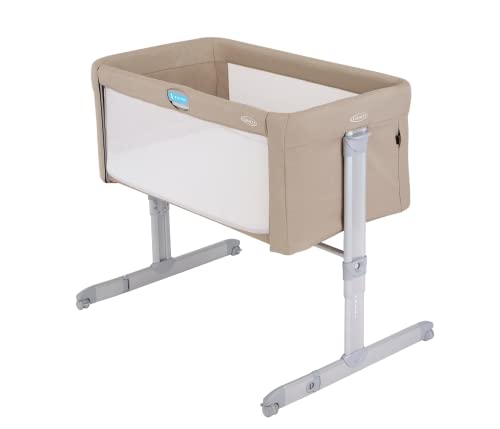Bedside Cosleeper
A bedside cosleeper is a bassinet which connects to the side of your adult bed. It's safe, so long as you follow the CSPC safety guidelines for infant sleep spaces.
These guidelines are similar to crib bedding standards. Find out more about the guidelines here. The most important factors to take into consideration when selecting the right bedside sleeper are Safety Comfort, Convenience, and Safety.

Safety
Many new parents and expectant mothers have chosen to cosleep which is also known as bed-sharing, in line with the American Academy of Pediatrics recommendation that infants sleep in the same room as their parents. The Academy recommends that room-sharing with a baby is less risky than sleeping in the same bed with parents, as it reduces the risk of Sudden Unexpected Infant Death (SIDS). While the AAP discourages bed-sharing, it does recommend that co-sleeping be done on a separate sleep surface to limit the risk of SIDS. This is the reason why the creation of the bedside cosleeper became so crucial for many families.
A bedside cosleeper is attached to a bed frame designed for adults. It's similar to a crib sleeper. The bedside cosleeper lets parents to keep an eye on their child and gives parents the freedom of an adult bed while keeping their child close to them. The best cosleepers are built with high-quality materials and adhere to strict safety standards. Be sure to look for the Juvenile Products Manufacturers Association (JPMA) stamp of approval, which demonstrates strict product testing and quality control to ensure your child's safe cosleeping experience.
The safety of a crib is dependent on several aspects. It is dependent on how it's set up and secured onto the mattress of the parent. If the bedside cosleeper is not connected to the bed of the parent in a manner that eliminates the gaps and openings where an infant can become trapped, it could be the risk of suffocation. It is essential that the attachment system of a bedside cosleeper be examined to determine if it is able to withstand the forces that might be imposed in the course of use, for example, a parent rolling onto and off the sleeper, or a 25-lb. The attachment system, or the corners on the bedside cosleeper should be exposed to an upward force.
The voluntary standard for bedside sleeping cribs is based on, the federal consumer safety standards for bassinets (16 CFR part 1218), including performance requirements for fabric-sided closed openings. The mandatory requirements of the standard also address head and neck entrapment hazards by requiring that after the application and release of 50 lbs. horizontal force at the attachment systems and at the corners of the bedside sleeper, gaps greater than 1.0 in. It is not permitted to create a gap that is greater than 1.0 in. ASTM's electronic Reading Room offers read-only versions of the standard.
Convenience
Many parents are reluctant to cosleep because they fear suffocation or SIDS, or because it is a "Ferberization" which requires children to sleep alone. Anthropologists have noticed for a long time that a lot of mammals, primates, and people from non-Western cultures sleep frequently. It could be because infants are calmed by the familiar voice of their mother, and it also helps them learn to self-soothe.
The top bedside sleepers have a clever design that attaches to the side of a mattress and swivels so you can easily access it to change diapers or feeds during the middle of the night. Find one with feet that can be adjusted to retract to accommodate various mattress sizes and a huge storage compartment for all your baby's necessities.
Pick a bedside crib that is compatible with the standard crib bedding so that it can be used in a safe manner as your child grows. You might also consider a convertible model that can transform into a play area or a more deep bassinet to last for years of use. bedside cot 6 months plus folds easily for transport.
Portability
A bedside cosleeper that has wheels or a light base is easier to move than one with a heavy wooden frame or base. The babybay bedside sleeper, HALO bassiNest essencetia, and Snoo Smart Sleeper are all portable. They come with adjustable feet that retract to fit platform mattresses and legs that fold up to allow maximum proximity to the mattress; 100 mesh sidewalls that allow airflow without covering baby's nose or mouth.
The Arm's Reach ClearVue is an excellent choice. It adjusts in 1" increments and can be used as a bassinet or portable bed. It also pivots to allow for quick access to the baby so that you can soothe her, feed her or check on them during the night.
